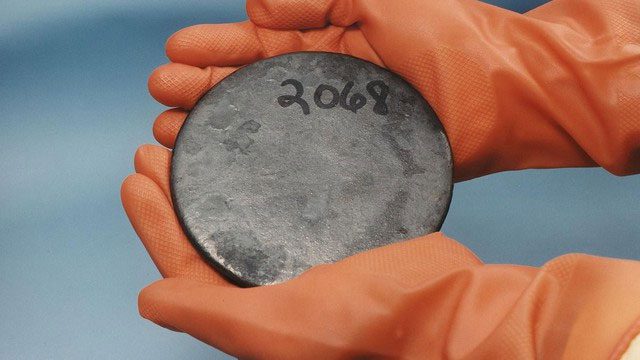Interesting Engineering reports that a team of scientists from the High Energy Accelerator Research Organization (KEK) in Japan has discovered a new uranium isotope named uranium-241.
First Discovery of Uranium-241 in 44 Years
In April 2023, scientists announced the successful production of Uranium-241 for the first time, filling a gap in the long list of isotopes of this highly radioactive heavy metal. The half-life of Uranium-241 is estimated to be around 40 minutes—too short for any Uranium-241 formed in a supernova or kilonova explosion to exist.
However, unlike many isotopes with half-lives measured in microseconds or nanoseconds, this isotope has a long enough lifespan for scientists to study its properties.

Uranium-241 is an extremely strong radioactive element. (Illustrative image).
Uranium-241 contains 92 protons and 149 neutrons, with an estimated short half-life of approximately 40 minutes.
(While atoms of a given element always have the same number of protons, isotopes or different versions of those elements can contain different numbers of neutrons in their nuclei. To be considered neutron-rich, an isotope must contain more neutrons than is common for that element. Uranium-241 is such an isotope).
“We measured the masses of 19 different actinide isotopes (of Protactinium, Uranium, Neptunium, and Plutonium) with high precision at the level of one part per million, including the detection and identification of this new Uranium isotope,” said Dr. Toshitaka Niwase, a research expert at the High Energy Accelerator Research Organization of Japan, at the Wako Nuclear Science Center (WNSC) in Japan, in an email to Live Science. “This is the first new discovery of a neutron-rich Uranium isotope in 44 years.”
Dr. Toshitaka Niwase is the lead author behind the discovery of the new Uranium isotope, with the findings published in the journal Physical Review Letters in 2023.
Isotopes can be stable, meaning they maintain their atomic configuration; or unstable, meaning they decay and transform into other elements by gaining or losing protons. The decay rate is measured by the half-life of the isotope, or the time it takes for half of the material to decay into other elements.
Dr. Toshitaka Niwase stated that the research team has yet to precisely measure the half-life of Uranium-241, but theoretical estimates suggest it is around 40 minutes.
For context, the half-life of Carbon-14 is 5,730 years, the half-life of the highly unstable Technetium-99m is 6 hours, and the half-life of Francium-223 is 22 minutes. The fastest-decaying isotope, Hydrogen-7, has disappeared half of its quantity in just 10^-23 seconds.
Why is the Discovery of a New Isotope (Uranium-241) Important?
The arrangement of protons and neutrons in an atomic nucleus follows specific rules based on the properties and structure of the nucleus.
The mass of an atom is slightly less than the total mass of its protons, neutrons, and electrons. Therefore, measuring the mass of Uranium and its neighboring elements provides essential nuclear information to understand the synthesis processes of such heavy elements in explosive astronomical events.
Moreover, nuclear physicists and astronomers are excited to learn about more Uranium isotopes, as it can strengthen scientific understanding of nuclear physics and is significant for the design of nuclear power plants as well as modeling exploding stars.
While Uranium-240 remains undiscovered, the identification of Uranium-241 means that every isotope leading up to Uranium-242 has now been created.
Among these, most have half-lives shorter than one second, often much shorter, so while the half-life of Uranium-241 still needs measurement, the estimated 40 minutes places it among the longer-lived isotopes of the 28 known Uranium isotopes, with none surpassing Uranium-238, which has a half-life of nearly 4.5 billion years!

A highly enriched Uranium ingot. (Photo: U.S. Department of Energy).
Uranium has no stable isotopes, but U-235 and U-238 take so long to decay that a significant portion of those atoms present at Earth’s formation still exist today, along with a small amount of U-233, U-234, and U-236.
All other Uranium isotopes must be produced in laboratories, and scientists hope to discover more Uranium isotopes in the future.
How Was Uranium-241 Discovered?
Two years after the lightest Uranium isotope was discovered, scientists have now found its second heaviest isotope.
Expert Niwase and his colleagues in Japan created Uranium-241 by bombarding a sample of Uranium-238 into the nucleus of Plutonium-198 at the KEK Isotope Separation System (KISS) at the RIKEN Chemical Physics Institute in Japan. The two isotopes then exchanged neutrons and protons—a phenomenon known as “multinucleon transfer.”
The research team then measured the masses of the created isotopes by observing the time it took for the obtained nuclei to travel a certain distance through a medium. The experiment also produced 18 new isotopes, all containing between 143 to 150 neutrons.
What Are “Magic Numbers”?
There is particular interest in magic number nuclei: those containing a specific number of protons or neutrons that confer high stability to the resulting nucleus. The heaviest “magic” nucleus known is lead (82 protons).
Dr. Niwase acknowledged that Uranium-241 may not have much scientific or practical utility, as this isotope is produced in extremely small quantities.
However, studying the behavior of such a heavy isotope could enhance our understanding of how neutron-rich atoms function.
The High Energy Accelerator Research Organization of Japan is striving to discover more neutron-rich actinide nuclei, shedding light on nuclear stability and the processes of astronomical nucleosynthesis.





















































